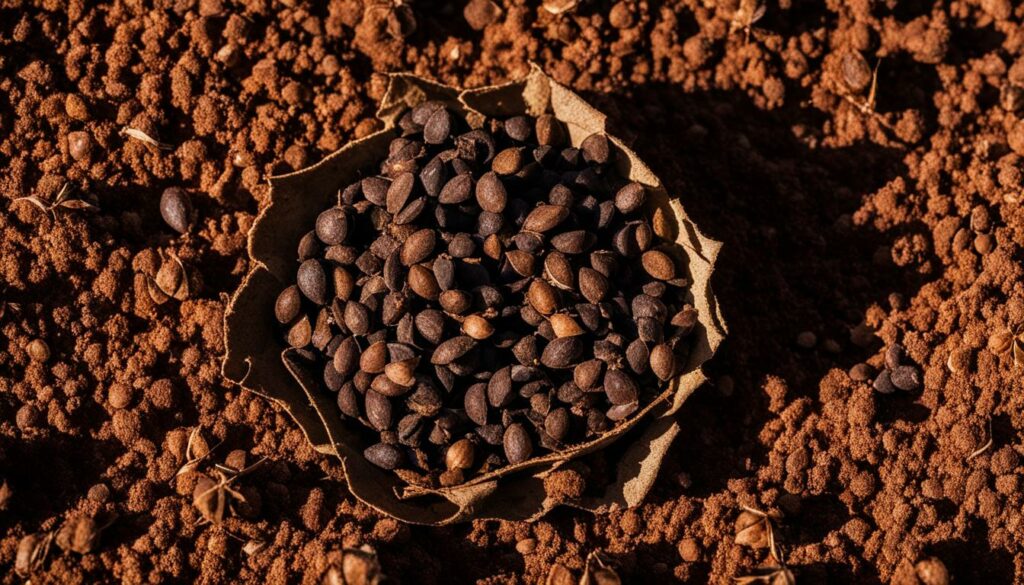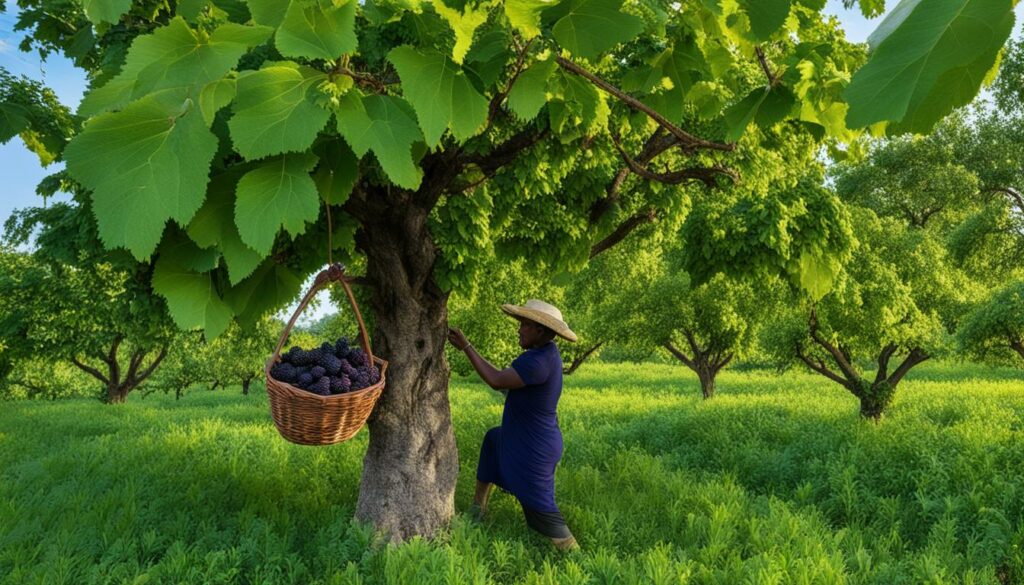Welcome to our comprehensive guide on planting mulberry seeds! Whether you’re a seasoned gardener or a beginner, we’ve got you covered with step-by-step instructions, helpful tips, and expert advice. So let’s dive right in and learn how to successfully plant mulberry seeds.
Planting mulberry seeds can be a bit challenging, but with the right knowledge and techniques, you’ll be able to grow your own mulberry trees in no time. In this guide, we’ll walk you through the entire process, from preparing the seeds to nurturing the seedlings and maintaining the trees.
Throughout this article, we’ll provide you with valuable tips for planting mulberry seeds, offer insights into the best practices for successful germination, and share expert advice on choosing the right planting site for your mulberry trees.
So, if you’re ready to embark on your mulberry seed planting journey and enjoy the delicious fruits of your labor, let’s get started!
Choosing the Right Planting Site
When it comes to planting mulberry trees from seeds, selecting the right planting site is crucial for their successful growth. Here are some best practices and tips for choosing an ideal location:
- Full Sun: Mulberry trees thrive in full sun, so choose an area that receives at least 6 hours of direct sunlight daily.
- Soil pH and Drainage: Mulberry trees prefer slightly acidic soil with a pH around 6.0. It’s important to ensure that the soil is well-draining to prevent waterlogged roots.
- Depth and Spacing: The planting site should have soil deep enough to accommodate the tree’s extensive root system. Mulberry trees should be spaced at least 20-30 feet apart to allow for their growth.
- Avoid Obstacles: Avoid planting mulberry trees near buildings, fences, or underground pipes, as the roots can potentially cause damage over time.
By selecting a suitable planting site, you provide the right conditions for mulberry trees to thrive and bear abundant fruit.
Benefits of Choosing the Right Site
Choosing the right planting site for your mulberry trees offers several advantages:
“Selecting a well-suited planting site ensures that mulberry trees receive optimal sunlight and soil conditions, promoting healthy growth and fruit production.”
Adequate sunlight exposure helps in photosynthesis, which is vital for the tree’s energy production. The right soil pH and drainage promote nutrient absorption and prevent root rot. Proper spacing allows each tree to access ample resources without competing for nutrients or space.
Potential Pitfalls to Avoid
When choosing a planting site, it is important to steer clear of potential pitfalls to ensure the longevity and success of your mulberry trees:
- Avoid planting in low-lying areas prone to waterlogging, which can suffocate the roots.
- Steer clear of areas with heavy foot traffic to prevent damage to the tree and its root system.
- Do not plant near trees or shrubs that may overshadow the mulberry trees, inhibiting their growth and fruit production.
By taking these considerations into account, you can create an optimal environment for your mulberry trees, ensuring healthy growth and abundant harvests for years to come.
Planting Mulberry Seeds
Planting mulberry seeds requires a specific process to ensure successful germination. Here is a step-by-step tutorial on how to sow mulberry seeds:
- Start with cold stratification: Soak the seeds in water for 4 days, replacing the water every 2 days to soften the seed coat.
- Prepare the seed for planting: After soaking, place the seeds onto a moistened paper towel and fold it over. Put the towel into a resealable baggie and label it.
- Refrigerate the seeds: Place the baggie with the seeds in the refrigerator for approximately 90 days to simulate a period of cold, moist stratification.
- Check for germination: Regularly check the paper towel to ensure it remains moist. Any seeds that begin to germinate should be immediately sown.
- Sow the seeds: Once the stratification period is complete, sow the seeds in containers with well-draining soil. Keep the soil moist until the seeds germinate.
- Expose to sunlight: Gradually expose the seedlings to increasing amounts of sunlight, starting with a few hours per day. This helps them adjust to outdoor conditions.
- Transplant outdoors: Wait until the last frost of the season has passed before transplanting the seedlings outdoors. Choose a sunny location with slightly acidic, moist soil.
Following these mulberry seed germination techniques will increase your chances of successful seedling growth. Remember to provide proper care and maintenance to your mulberry trees as they continue to grow.

Tips for Maintaining Mulberry Trees
Once you have successfully planted your mulberry seeds and they have begun to grow into trees, it’s important to properly maintain them to ensure their healthy development. Here are some expert tips on maintaining mulberry trees:
Regular Watering
Mulberry trees, especially young ones, require regular watering to establish strong root systems. Watering should be done consistently, providing about an inch of water per week. This is especially crucial during the first year of growth. As the trees mature, they become more drought-tolerant and can withstand longer periods without water.
Well-Draining Soil
Mulberry trees can tolerate a variety of soil types but prefer well-draining soil. Avoid planting them in areas with heavy clay or soil that tends to retain water. To improve drainage, consider adding organic matter such as compost or peat moss to the soil before planting.
Minimal Fertilization
Mulberry trees do not require excessive fertilization. A yearly application of compost or a slow-release fertilizer with a balanced ratio of nutrients, such as 10-10-10, in late winter or early spring is sufficient. Be careful not to over-fertilize, as this can lead to excessive foliage growth at the expense of fruit production.
Pruning and Training
Pruning should be done while the trees are dormant, typically in late winter. Remove any dead or damaged branches, as well as any branches that are crossing or rubbing against each other. It is also beneficial to train the trees outward, using stakes or trellises, to promote better air circulation and easier harvesting. This helps to prevent disease and encourages the development of a healthy canopy.
By following these expert tips, you can ensure the proper maintenance of your mulberry trees and enjoy a bountiful harvest of delicious mulberries for years to come.

Harvesting Mulberry Trees
Harvesting mulberry trees requires proper timing and techniques to ensure the best flavor and quality of the fruit. Mulberry leaves should be harvested in the spring and summer months when they are young and tender. They can be used for various purposes such as making tea, feeding livestock, or even as a nutritious addition to salads. However, it’s important to note that the leaves become tough and lose their flavor as the summer progresses into fall.
When it comes to harvesting the mulberries themselves, timing is essential. The berries should be allowed to fully ripen on the tree before harvesting. This ensures that they are at their peak sweetness and juiciness. The berries are usually ready for picking in the fall, around late summer to early autumn. Simply pluck the berries from the tree, being careful not to damage the delicate fruit.
To preserve the seeds for future planting, it is important to remove them from the ripe berries and dry them thoroughly. This can be done by spreading the seeds out on a clean, dry surface and allowing them to air-dry for a few days. Once completely dry, store the seeds in a cool, dry place until you’re ready to plant them. Properly stored mulberry seeds can maintain their viability for several years.

Benefits of Harvesting Mulberry Trees
Harvesting mulberry trees not only provides delicious fruits and leaves, but it also offers several other benefits. Firstly, mulberries are packed with essential nutrients, including vitamin C, iron, and antioxidants. Consuming mulberries can help boost your immune system, promote healthy digestion, and even improve your skin health.
In addition, mulberry trees are often a favorite among wildlife, attracting birds and other small animals to your garden. This can create a vibrant and diverse ecosystem, bringing life and beauty to your outdoor space. Furthermore, mulberry trees provide shade and can help cool down your surroundings during hot summer months.
| Benefits of Harvesting Mulberry Trees | Summary |
|---|---|
| Abundance of nutritious fruits and leaves | Delicious and versatile, mulberry fruits and leaves offer a wide range of culinary and health benefits. |
| Attracts wildlife | Mulberry trees can attract birds and other wildlife, enhancing the biodiversity of your garden. |
| Provides shade | The large, leafy canopy of a mulberry tree offers natural shade and helps cool down outdoor spaces. |
Harvesting mulberry trees not only provides a delightful culinary experience but also brings various benefits to your garden and overall well-being. From the delicious fruits and leaves packed with essential nutrients to the attraction of wildlife and the cooling shade it provides, mulberry trees are a worthwhile addition to any garden or outdoor space.
Conclusion
Planting and growing mulberry trees from seeds can be a rewarding experience. While the germination process may pose challenges, following the step-by-step mulberry seed planting process can increase your chances of success.
Choosing the right planting site is crucial for the growth of your mulberry trees. Remember to select an area that receives full sun and has slightly acidic soil. Adequate spacing between trees is important to accommodate their growth.
Maintaining your mulberry trees involves regular watering, especially during the first year. Once established, they are drought-tolerant and require minimal fertilization. Pruning and training the trees will facilitate easier harvesting and a healthier canopy.
When it comes to harvesting your mulberry trees, remember that the leaves are best harvested in spring and summer, while the berries can be enjoyed in the fall. To save seeds for future plantings, allow the berries to ripen fully on the tree, remove the seeds, and store them in a cool, dry place.
By following these best practices for growing mulberry from seeds, you can enjoy a bountiful harvest of sweet and juicy berries for years to come. Happy planting!
FAQ
How long does it take for mulberry seeds to germinate?
Mulberry seeds require approximately 90 days of cold, moist stratification before they begin to germinate.
What is cold stratification?
Cold stratification is a method of mimicking the natural winter conditions that mulberry seeds need to germinate. It involves soaking the seeds in water, placing them on a moistened paper towel, and refrigerating them for 90 days.
How should I prepare mulberry seeds for stratification?
Before stratifying, soak the seeds in water for 4 days, replacing the water every 2 days. After soaking, place the seeds onto a moistened paper towel, fold it over, and put it into a resealable baggie. Label the bag and refrigerate it for approximately 90 days.
Can I grow mulberry trees from seeds indoors?
Yes, mulberry seeds can be grown indoors in containers. Gradually expose the seedlings to increasing amounts of sunlight before transplanting them outdoors.
How much sunlight do mulberry trees need?
Mulberry trees prefer full sun, so it is important to choose a planting site that receives direct sunlight for most of the day.
How often should I water mulberry trees?
For established trees, provide about an inch of water per week. Mulberry trees are drought-tolerant once established but still require regular watering, especially during their first year.
How should I prune mulberry trees?
Pruning should be done while the trees are dormant, typically in late winter. It is beneficial to train the trees outward for easier harvesting and increased canopy size.
When should I harvest mulberry leaves and berries?
Mulberry leaves should be harvested in spring and summer, as they become tough and lose their flavor in the late summer and fall. The berries can be collected and enjoyed in the fall.
How long can mulberry trees produce fruit?
Once established, mulberry trees can be productive for 15-20 years or more.
How do I save seeds from mulberry trees?
Allow the berries to fully ripen on the tree before harvesting. Remove the seeds from the ripe berries and dry them thoroughly before storing them in a cool, dry place.





